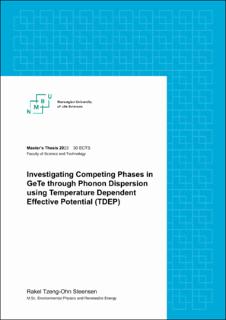| dc.description.abstract | Germanium telluride (GeTe) has for many years attracted attention because of its good thermoelectric properties. The remarkably low lattice thermal conductivity, despite the simple crystal structure, is an interesting property and gives rise to the question of why. Many thermoelectric materials that are being researched often have more complex crystal
structures compared to the diatomic GeTe.
In GeTe a phase transition occurs around temperatures T = 630 K ∼ 740 K. Previous studies have found that when the trigonal structure is nearing the phase transition, the shape of the structure shifts towards a more cubic structure. This change from a quasi-cubic to a cubic structure is thought to be related to the low lattice thermal conductivity of GeTe.
The effect caused by changing the angle of the trigonal structure of GeTe is what this study investigates, in addition to finding the phase transition. First-principles calculations of the Free energy and phonon dispersion relation have been made at finite temperatures and various trigonal angles using density functional theory (DFT) and temperature dependent effective potential (TDEP). The volumes of the cubic and trigonal cells have been kept constant at the ground state calculated volumes, meaning that the thermal expansion has not been included.
Precise force constants were found using an iterative process where the new iteration is built on the calculations of the previous iterations. This method was successful at improving the precision of the force constants, as high precision is necessary for phonon calculations.
This study shows that the volume of the unit cell is very important when calculating the Free energy. In addition to this, it is important to optimise the atomic positions in the trigonal unit cell. This is because the atomic positions influence the phonon dispersion much. Therefore, to be able to describe the phase transition and dispersion relation of GeTe precisely, temperature, volume, angle and atomic position need to be taken into consideration. In this thesis, only temperature and angle have been included meaning the results are somewhat insufficient in describing the phonon dispersion relation at the phase transition.
In addition to the complexity of the system, the findings suggest that as the temperature decreases, the cubic structure exhibits phonon softening and broadening. This indicates that there is a phase transition occurring in GeTe and that near the phase transition the lattice thermal conductivity is low. | |
